A Comprehensive Review of Biomass Gasification Characteristics in Fluidized Bed Reactors: Progress, Challenges, and Future Directions
Abstract
1. Introduction
2. Biomass Gasification Reactor Configurations
2.1. Fixed Bed Gasifier
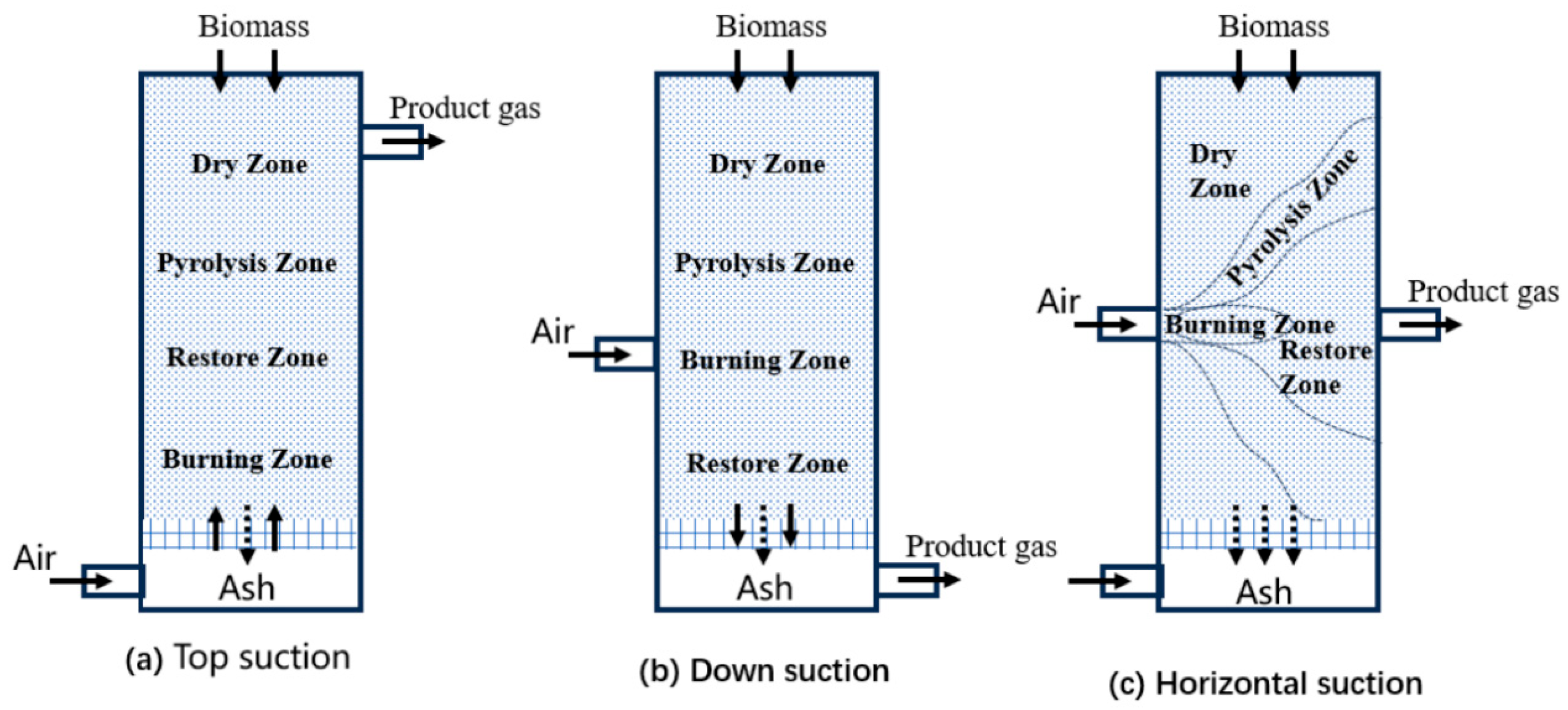
2.2. Fluidized Bed Gasifiers
2.2.1. Bubbling Fluidized Bed (BFB) Gasifiers
2.2.2. Circulating Fluidized Bed (CFB) Gasifiers
2.2.3. Dual Fluidized Bed (DFB) Gasifiers
2.3. Comparative Analysis and Conclusions
3. Gas–Solid Flow Characteristics of Biomass Fluidized Bed
3.1. Fluidizing Gas Velocity
3.2. Gas–Solid Mixing Uniformity
3.3. Particle Residence Time
3.4. Analysis and Conclusions
4. Biomass Gasification Medium
4.1. Single Gasification Medium
4.1.1. Air
4.1.2. Oxygen (O2)
4.1.3. Water Vapor (H2O)
4.1.4. Carbon Dioxide (CO2)
4.2. Combined Gasification
4.2.1. Air/H2O
4.2.2. Oxygen-Enriched Water Vapor (Air-O2/H2O)
4.2.3. Oxygen–Water Vapor (O2/H2O)
4.3. Performance Comparison and Optimization Direction
5. Conclusions
6. Numerical Simulation Analysis of Pilot-Scale Biomass Fluidized Bed Gasification
Author Contributions
Funding
Data Availability Statement
Conflicts of Interest
Abbreviations
| BFBs | Bubbling fluidized beds |
| CFBs | Circulating fluidized beds |
| DFBs | Dual fluidized beds |
| LHV | Lower heating value |
| ER | Equivalence ratio |
| MP-PIC | Multiphase particle-in-cell |
| CPFD | Computational Particle Fluid Dynamics |
References
- Niu, Y. Simulation Study on Flow and Heat-Mass Transfer Characteristics of Downdraft Biomass Gasification. Master’s Thesis, Taiyuan University of Technology, Taiyuan, China, 2023. Volume 105. [Google Scholar]
- Ismail, T.M.; El-Salam, M.A. Parametric studies on biomass gasification process on updraft gasifier high temperature air gasification. Appl. Therm. Eng. 2017, 112, 1460–1473. [Google Scholar] [CrossRef]
- Cerone, N.; Zimbardi, F.; Contuzzi, L.; Baleta, J.; Cerinski, D.; Skvorčinskienė, R. Experimental investigation of syngas composition variation along updraft fixed bed gasifier. Energy Convers. Manag. 2020, 221, 113116. [Google Scholar] [CrossRef]
- Singh, A.; Shivapuji, A.M.; Dasappa, S. Hydrogen production through agro-residue gasification and adsorptive separation. Appl. Therm. Eng. 2023, 234. [Google Scholar] [CrossRef]
- Zhang, Y.; Zhou, A.; Li, Z.; Zhang, H.; Xiong, Y.; Xiao, R.; Hu, Z.; Wang, X. Numerical simulation analysis of biomass gasification and rich-H2 production process in a downdraft gasifier. J. Energy Inst. 2024, 114, 101596. [Google Scholar] [CrossRef]
- Min, P.; Dapeng, B.; Ruyi, S.; Liu, S. Research status and future challenges of biomass gasifiers in China. Energy Chem. Ind. 2020, 41, 1–6. [Google Scholar]
- Liu, N.; Liu, Z.; Wang, Y.; Zhou, T.; Zhang, M.; Yang, H. Clean and Efficient Thermochemical Conversion Technologies for Biomass in Green Methanol Production. Biomass 2025, 5, 13. [Google Scholar] [CrossRef]
- Dong, Y.; Sun, Y. Development of wet purification system for straw pyrolysis gasification. Trans. CSAM 2000, 31, 48–49. [Google Scholar]
- Kulkarni, A.; Baker, R.; Abdoulmomine, N.; Adhikari, S.; Bhavnani, S. Experimental study of torrefied pine as a gasification fuel using a bubbling fluidized bed gasifier. Renew. Energy 2016, 93, 460–468. [Google Scholar] [CrossRef]
- Hwang, I.S.; Sohn, J.; Lee, U.D.; Hwang, J. CFD-DEM simulation of air-blown gasification of biomass in a bubbling fluidized bed gasifier: Effects of equivalence ratio and fluidization number. Energy 2021, 219, 119533. [Google Scholar] [CrossRef]
- Nguyen, N.M.; Alobaid, F.; May, J.; Peters, J.; Epple, B. Experimental study on steam gasification of torrefied woodchips in a bubbling fluidized bed reactor. Energy 2020, 202, 117744. [Google Scholar] [CrossRef]
- Thakkar, M.; Makwana, J.; Mohanty, P.; Shah, M.; Singh, V. In bed catalytic tar reduction in the autothermal fluidized bed gasification of rice husk: Extraction of silica, energy and cost analysis. Ind. Crop. Prod. 2016, 87, 324–332. [Google Scholar] [CrossRef]
- Gao, Z.; Zhu, D.; Chen, Y.; Liu, S.; Wang, Q. Experimental study on air gasification characteristics of agricultural and forestry wastes in circulating fluidized bed. Power Gener. Technol. 2024, 45, 535–544. [Google Scholar]
- Ramzan, N.; Athar, M.; Begum, S.; Ahmad, S.W.; Naveed, S. Simulation of circulating fluidized bed gasification for characteristic study of pakistani coal. Pol. J. Chem. Technol. 2015, 17, 66–78. [Google Scholar] [CrossRef]
- Liu, H.; Wang, Z.; Huang, Y.; Zhou, M.; Jia, C.; Gu, Z.; Sun, B.; Wang, Q. CPFD simulations of corn stalk gasification in a circulating fluidized bed. Chem. Eng. Res. Des. 2024, 205, 246–256. [Google Scholar] [CrossRef]
- Wu, H.; Hanna, A.M.; Jones, D.D. Fluidized-bed gasification of dairy manure by Box–Behnken design. Waste Manag. Res. 2012, 30, 506–511. [Google Scholar] [CrossRef]
- Corella, J.; Toledo, J.M.; Molina, G. Steam gasification of coal at low−medium (600−800 °C) temperature with simultaneous CO2 capture in fluidized bed at atmospheric pressure: The effect of inorganic species. 1. Literature review and comments. Ind. Eng. Chem. Res. 2007, 46, 6831–6839. [Google Scholar] [CrossRef]
- Karl, J.; Pröll, T. Steam gasification of biomass in dual fluidized bed gasifiers: A review. Renew. Sustain. Energy Rev. 2018, 98, 64–78. [Google Scholar] [CrossRef]
- Winaya, I.N.S.; Wirawan, I.K.G.; Darma, I.W.A.; Lokantara, I.P.; Hartati, R.S. An increase in bed temperature on gasification of dual reactor fluidized bed. E3S Web Conf. 2018, 67, 02059. [Google Scholar] [CrossRef]
- Wilk, V.; Kitzler, H.; Koppatz, S.; Pfeifer, C.; Hofbauer, H. Gasification of waste wood and bark in a dual fluidized bed steam gasifier. Biomass- Convers. Biorefinery 2011, 1, 91–97. [Google Scholar]
- Gai, C.; Guo, Y.; Liu, T.; Peng, N.; Liu, Z. Hydrogen-rich gas production by steam gasification of hydrochar derived from sewage sludge. Int. J. Hydrog Energy 2020, 45, 1997–2006. [Google Scholar] [CrossRef]
- Wang, J.; Wu, X.; Dong, H.; Pan, Y.; Chen, H. Numerical simulation of gasification characteristics in a circulating fluidized bed biomass gasifiers. Biomass- Convers. Biorefinery 2025, 15, 6269–6286. [Google Scholar]
- Zhao, L.; Lu, Y. Hydrogen production by biomass gasification in a super critical water fluidized bed reactor: A CFD-DEM study. J. Supercrit. Fluids 2018, 131, 26–36. [Google Scholar] [CrossRef]
- Liu, H.; Li, J.; Wang, Q. Simulation of gas–solid flow characteristics in a circulating fluidized bed based on a computational particle fluid dynamics model. Powder Technol. 2017, 321, 132–142. [Google Scholar] [CrossRef]
- Lu, J.; Jin, B. Three-dimensional numerical simulation of biomass fluidized bed gasification. Acta Energiae Solaris Sin. 2018, 39, 2863–2868. [Google Scholar]
- Chang, J.; Zhang, K.; Zhu, W.; Yang, Y. Gas-solid flow characteristics and contact efficiency in dual circulating fluidized bed riser. Pet. Process. Petrochem. 2016, 47, 16–24. [Google Scholar]
- Fang, M. DEM-LES Simulation of Dense Gas-Solid Two-Phase Flow in Circulating Fluidized Bed. Ph.D. Thesis, Zhejiang University, Hangzhou, China, 2013. [Google Scholar]
- Wan, Z.; Lu, Y. Numerical simulation of local and global mixing/segregation characteristics in a gas–solid fluidized bed. Chin. J. Chem. Eng. 2022, 44, 72–86. [Google Scholar] [CrossRef]
- Yang, H.; Wirsum, M.; Lü, J.; Yang, H. Modeling study on particle residence time in CFB boilers. J. Eng. Therm. Energy Power 2003, 143–146. [Google Scholar]
- Lan, B.; Xu, J.; Liu, Z.; Wang, J. Scale-up simulation study on particle residence time distribution characteristics in continuous dense-phase fluidized bed. CIESC J. 2021, 72, 521–533. [Google Scholar]
- Gao, W.; Zhang, J.; Wang, Y.; Huang, B.; Xu, G. Particle residence time distribution in continuous feeding/discharging bubbling fluidized bed. Chin. J. Process Eng. 2012, 12, 9–13. [Google Scholar]
- Basu, P. Combustion and Gasification in Fluidized Beds; CRC Press: Boca Raton, FL, USA, 2006. [Google Scholar]
- Huang, Y.; Wang, Y.; Zhang, C.; Xu, G. Optimization of gas residence time for high-calorific syngas production in a dual-bed gasifier. Appl. Energy 2015, 250, 1480–1489. [Google Scholar]
- Li, J.; Zhang, S.; Shao, J.; Yang, H.; Chen, H. Pilot-scale experimental study on typical biomass fluidized bed gasification. Energy Environ. 2020, 42–45. [Google Scholar] [CrossRef]
- Li, W.; Wu, S.; Wu, Y.; Huang, S.; Gao, J. Gasification characteristics of biomass at a high-temperature steam atmosphere. Fuel Process. Technol. 2019, 194, 106090. [Google Scholar] [CrossRef]
- Li, B.; Chen, H.; Yang, H.; Wang, X.; Dai, Z. Simulation study on biomass oxygen gasification for syngas production based on ASPEN PLUS platform. J. Combust. Sci. Technol. 2011, 17, 432–436. [Google Scholar]
- Kurkela, E.; Kurkela, M. Hiltunen Pilot-scale development of pressurized air-blown fluidized-bed gasification for biomass. Energy Fuels 2013, 27, 6713–6722. [Google Scholar]
- Phuiran, C.; Takarada, T.; Chaiklangmuang, S. Hydrogen-rich gas from catalytic steam gasification of eucalyptus using nickel-loaded Thai brown coal char catalyst. Int. J. Hydrog Energy 2014, 39, 3649–3656. [Google Scholar] [CrossRef]
- Fremaux, S.; Beheshti, S.-M.; Ghassemi, H.; Shahsavan-Markadeh, R. An experimental study on hydrogen-rich gas production via steam gasification of biomass in a research-scale fluidized bed. Energy Convers. Manag. 2015, 91, 427–432. [Google Scholar] [CrossRef]
- Loha, C.; Chattopadhyay, H.; Chatterjee, P.K. Thermodynamic analysis of hydrogen rich synthetic gas generation from fluidized bed gasification of rice husk. Energy 2011, 36, 4063–4071. [Google Scholar] [CrossRef]
- Anca-Couce, A. Reaction mechanisms and multi-scale modelling of lignocellulosic biomass pyrolysis. Prog. Energy Combust. Sci. 2016, 53, 41–79. [Google Scholar] [CrossRef]
- Pandey, B.; Sheth, P.N.; Prajapati, Y.K. Air-CO2 and oxygen-enriched air-CO2 biomass gasification in an autothermal downdraft gasifier: Experimental studies. Energy Convers. Manag. 2022, 270, 116216. [Google Scholar] [CrossRef]
- Zhu, X.; Wang, Z.; Ocone, R.; Wang, H. MP-PIC simulation on CO2 gasification of biomass in a pilot plant circulating fluidized bed gasifier. Fuel 2023, 332, 125992. [Google Scholar] [CrossRef]
- Ren, X.; Yang, H.; Chen, Q.; Zhao, C.; Zhang, S.; Chen, H. Numerical simulation of CO2 biomass gasification. Acta Energiae Solaris Sinica 2021, 42, 1–9. [Google Scholar]
- Sharma, S.; Sheth, P.N. Air-steam biomass gasification: Experiments, modeling and simulation. Energy Convers. Manag. 2016, 110, 307–318. [Google Scholar] [CrossRef]
- Erkiaga, A.; Lopez, G.; Amutio, M. Syngas from steam-oxygen fluidized bed gasification of MSW: Effect of temperature and oxygen concentration. Fuel Process. Technol. 2015, 133, 202–208. [Google Scholar]
- Ye, R.; Liu, J.; Li, X.; Zheng, L.; Li, M.; Wang, G.; Zhang, D. Experimental study on oxygen-steam oriented gasification in biomass bubbling fluidized bed. Acta Energiae Solaris Sin. 2016, 37, 1636–1642. [Google Scholar]
- Frigo, S.; Flori, G.; Barontini, F.; Gabbrielli, R.; Sica, P. Experimental and numerical performance assessment of green-hydrogen production from biomass oxy-steam gasification. Int. J. Hydrogen Energy 2024, 71, 785–796. [Google Scholar] [CrossRef]
- Xu, W.; Ren, J.; Ying, H.; Sun, Y.; Xu, Y. Hydrogen-rich gas production from bamboo chips via oxygen-steam gasification. Biomass Chem. Eng. 2023, 57, 44–50. [Google Scholar]
- Su, D.; Liu, H.; Zhou, Z.; Yin, X.; Wu, C. Experimental study on oxygen-steam gasification of biomass in a fluidized bed. J. Fuel Chem. Technol. 2012, 40, 309–314. [Google Scholar]
- Ruoppolo, G.; Cante, A.; Chirone, R.; Miccio, F.; Stanzione, V. Fluidized bed gasification of coal/biomass slurries. In Proceedings of the 20th International Conference on Fluidized Bed Combustion, Xi’an, China, 18–21 May 2009; Istituto di Ricerche sulla Combustione–CNR: Napoli, Italy, 2012; pp. 1–10. [Google Scholar]

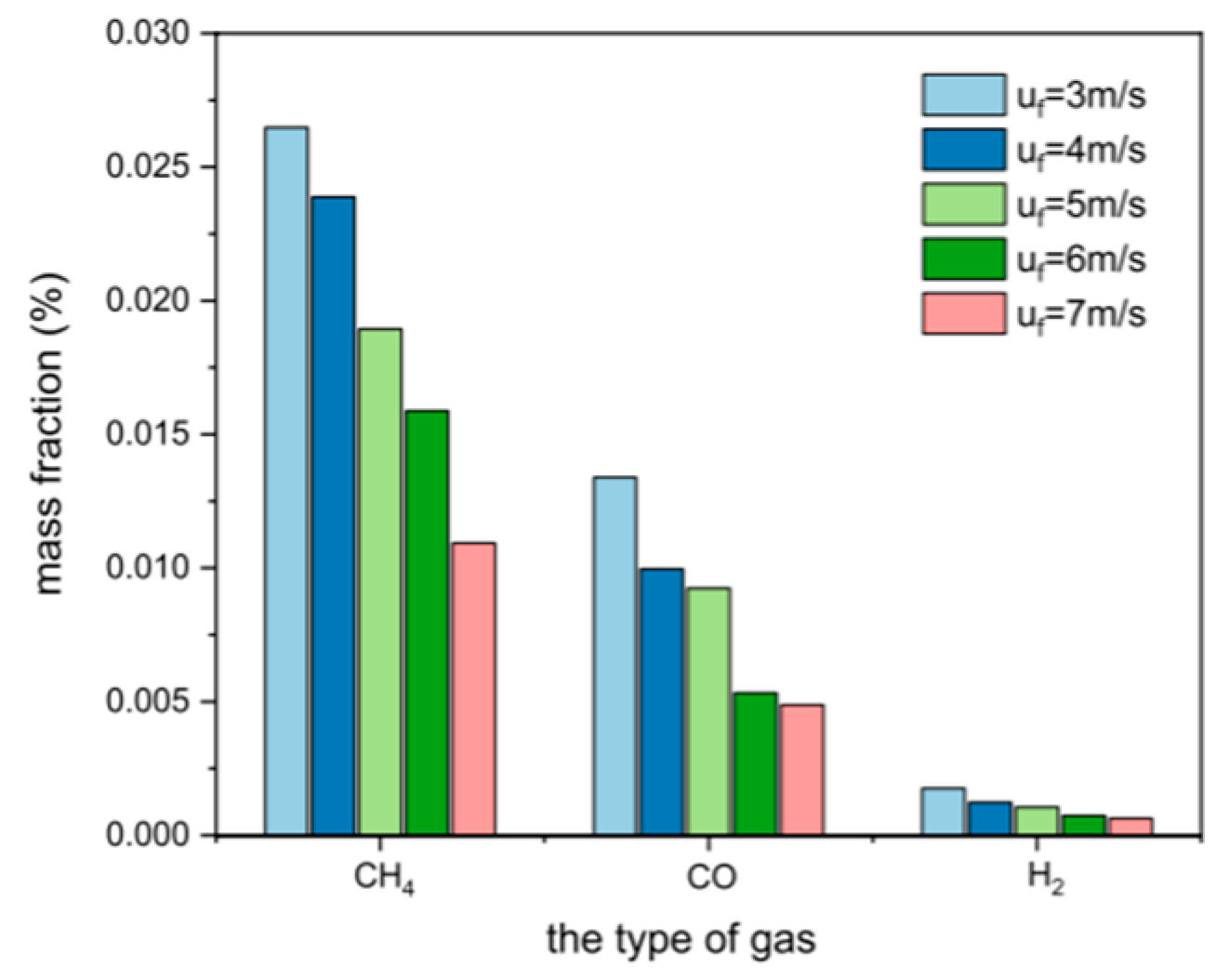
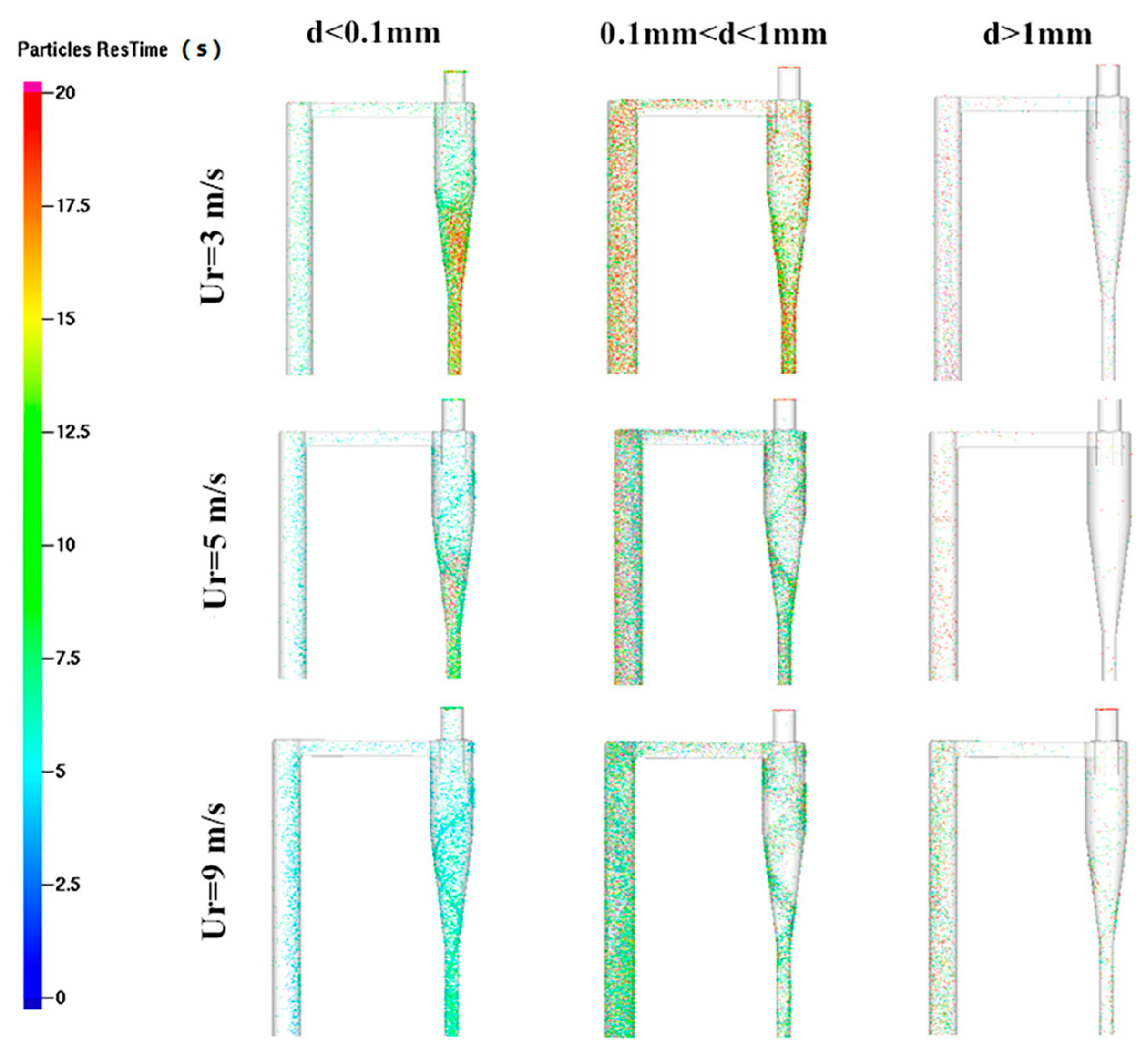
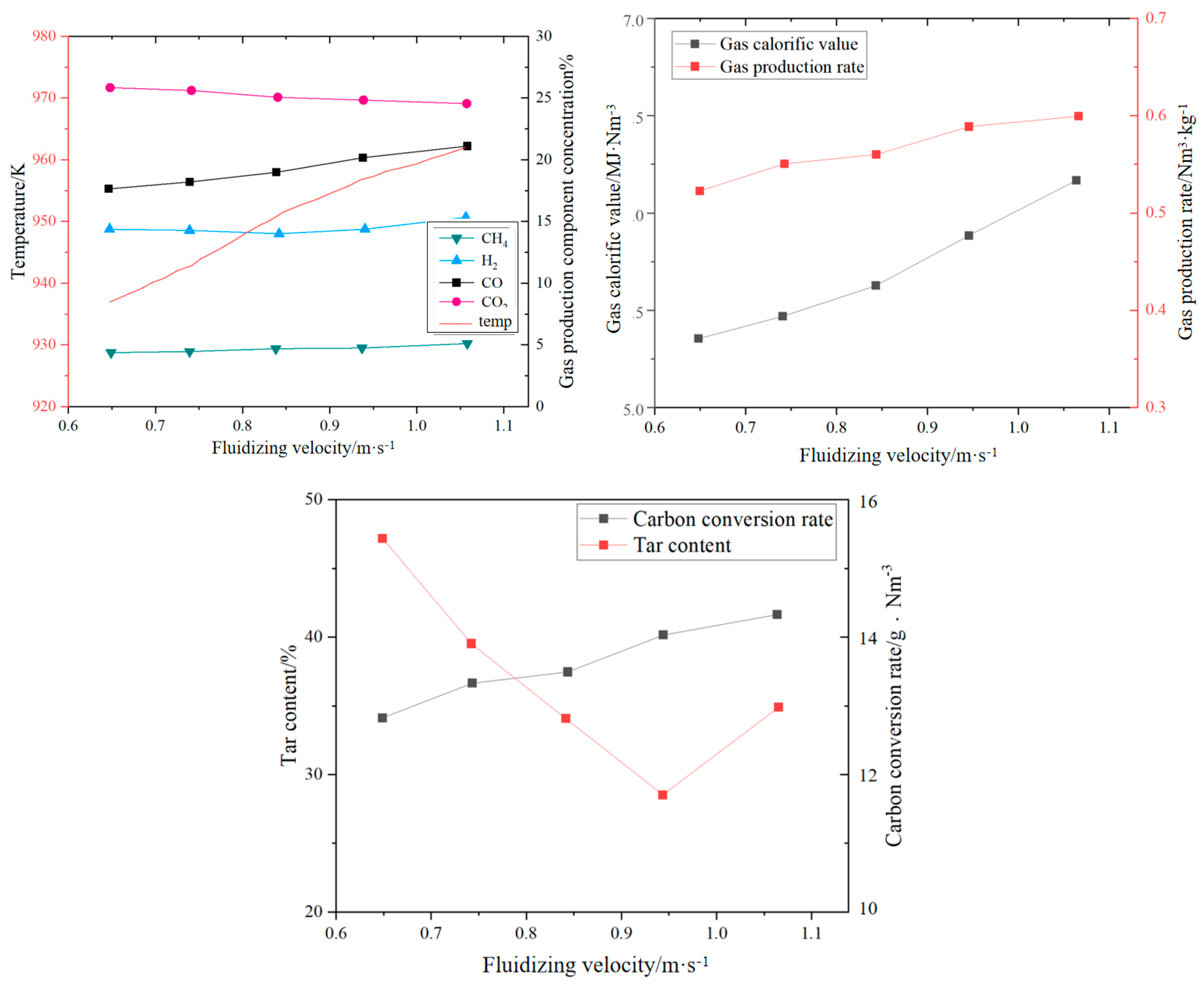
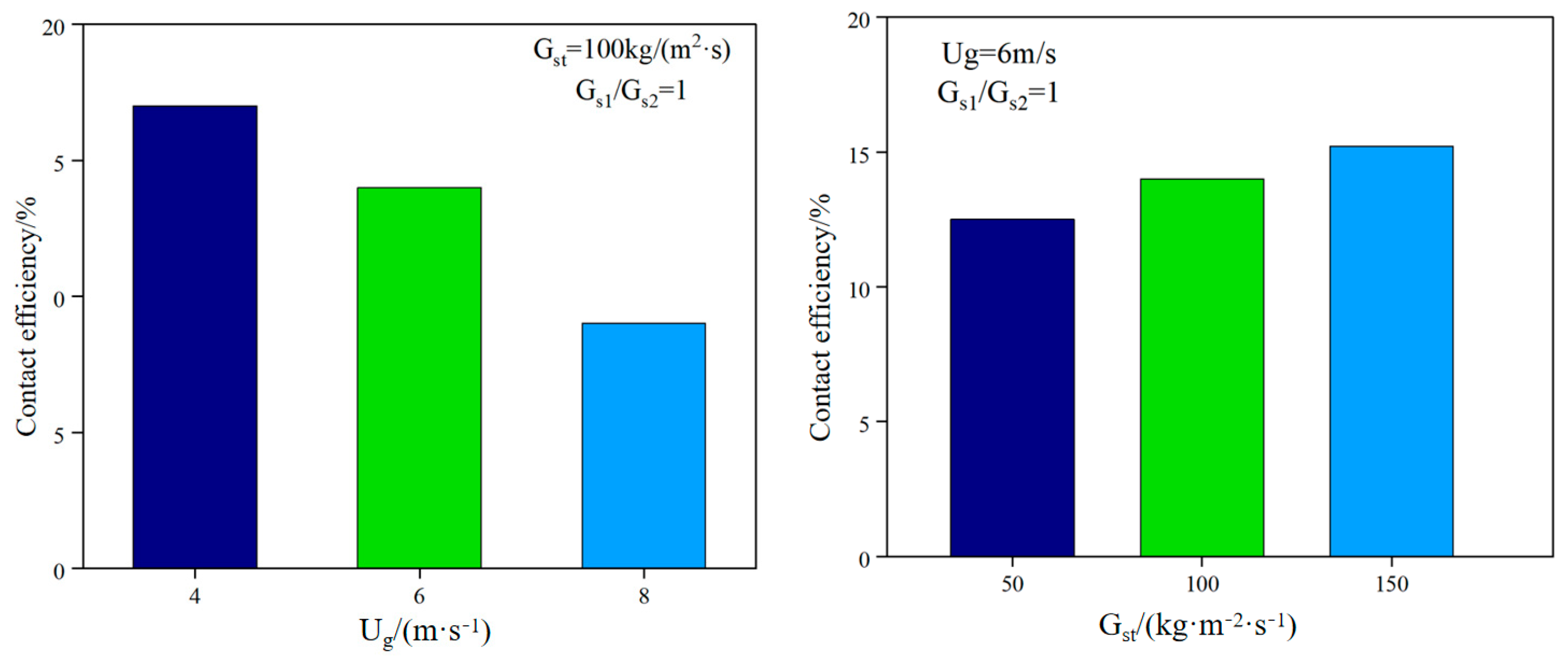
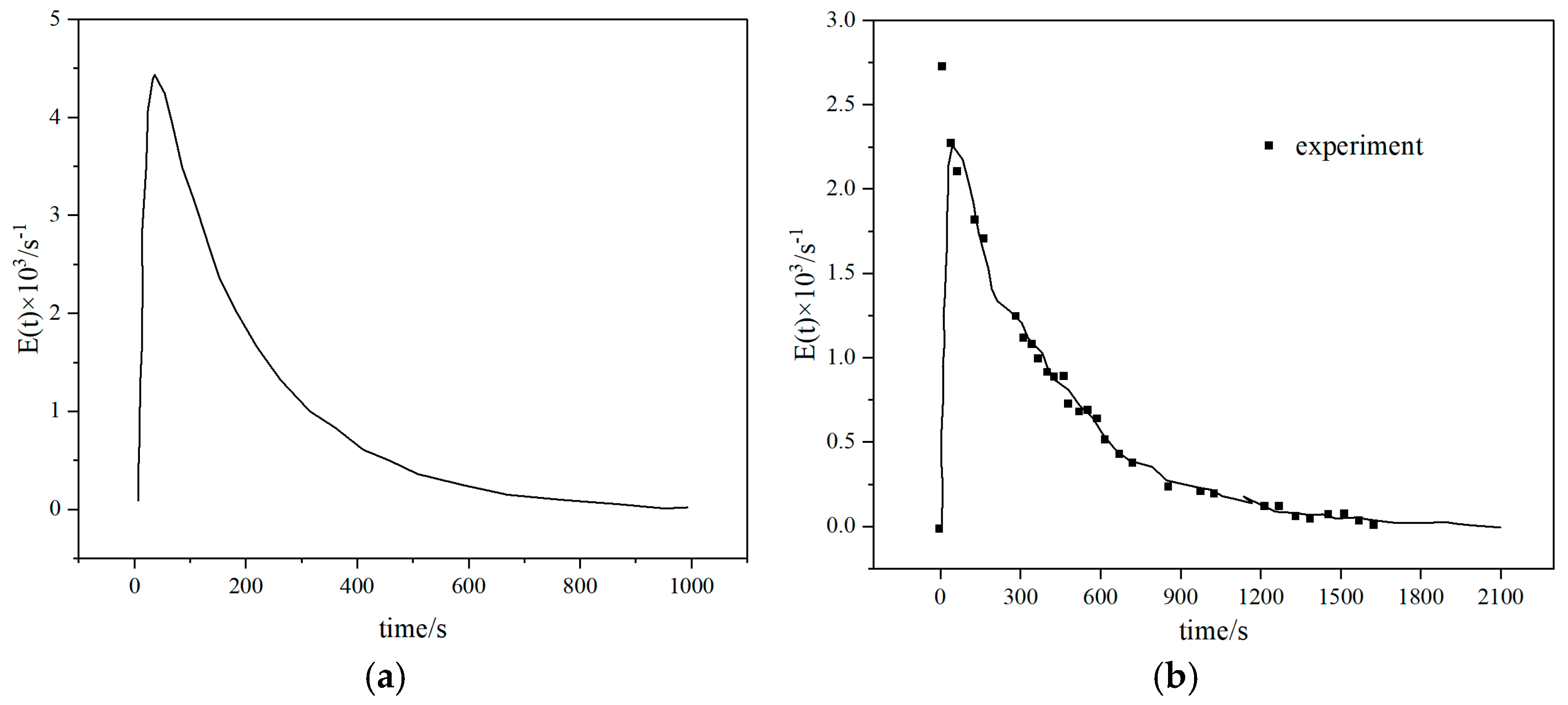

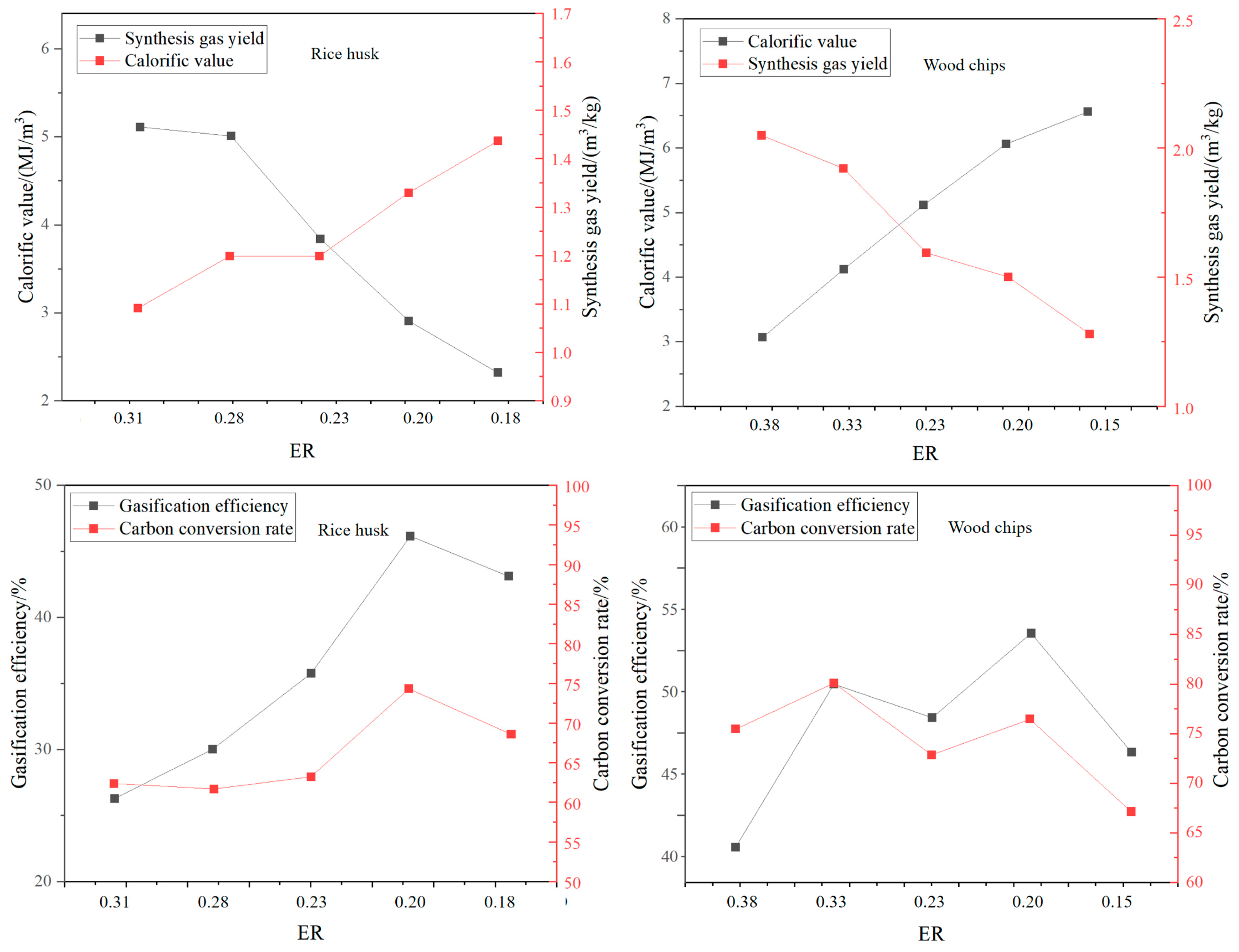
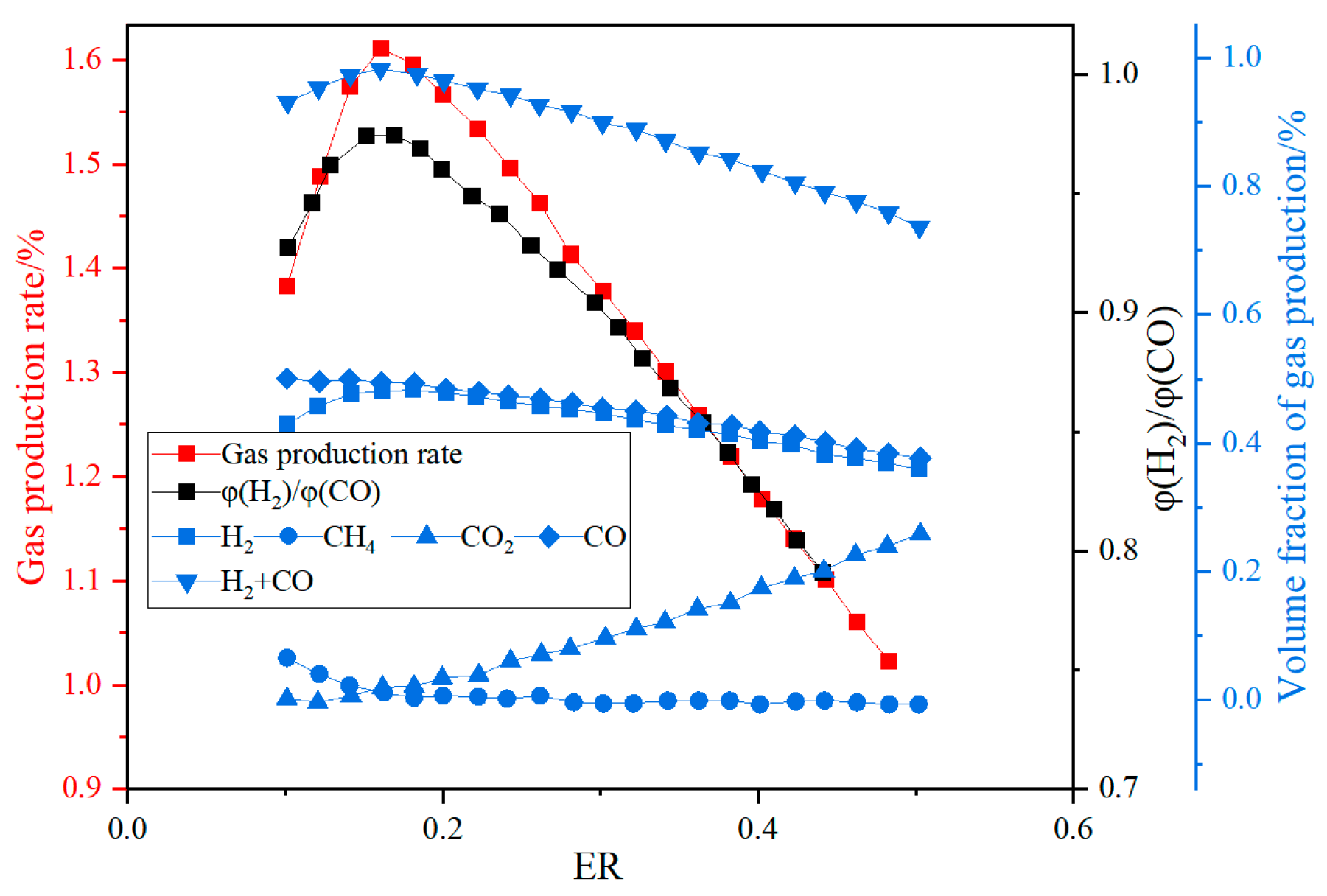
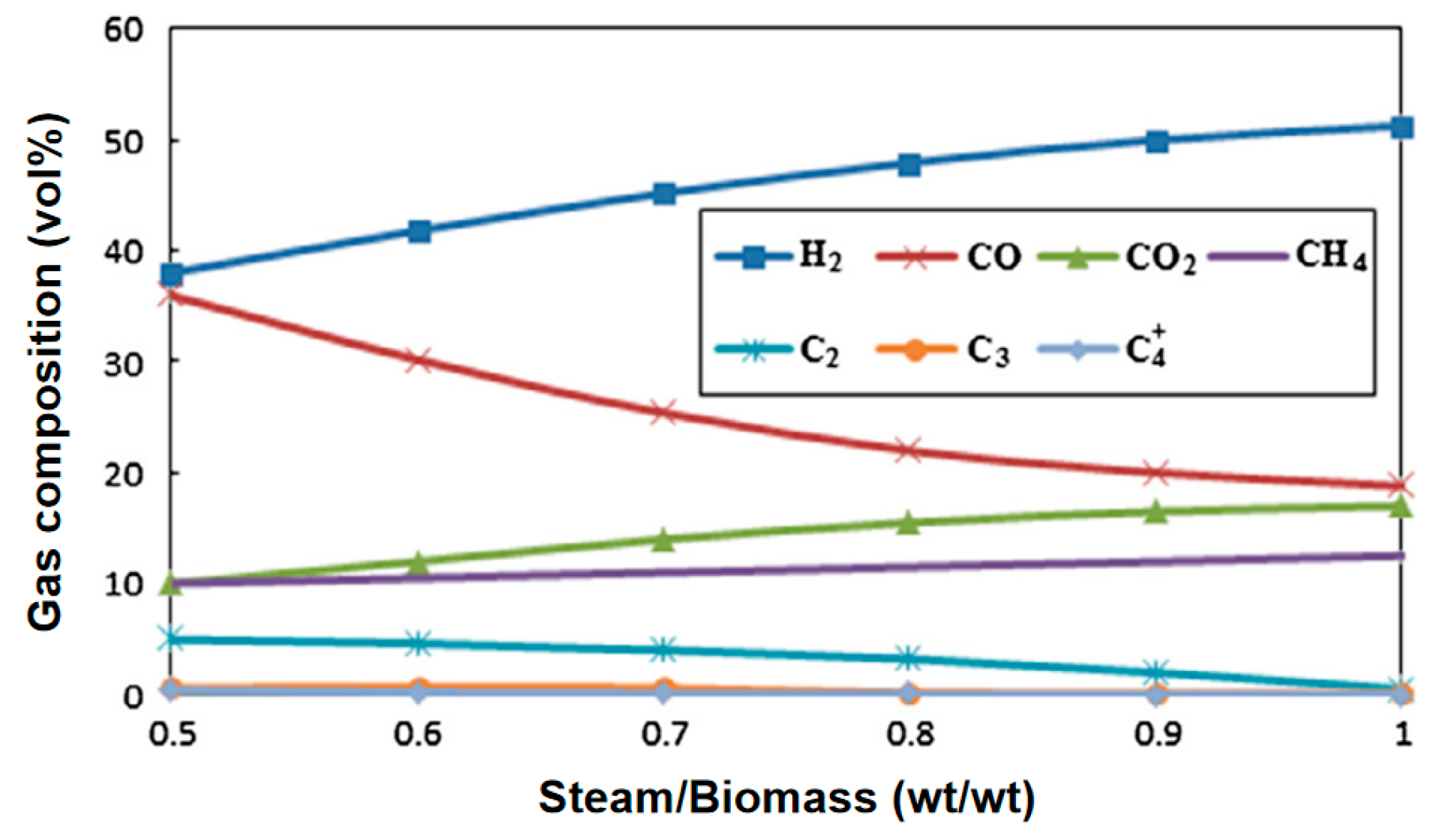
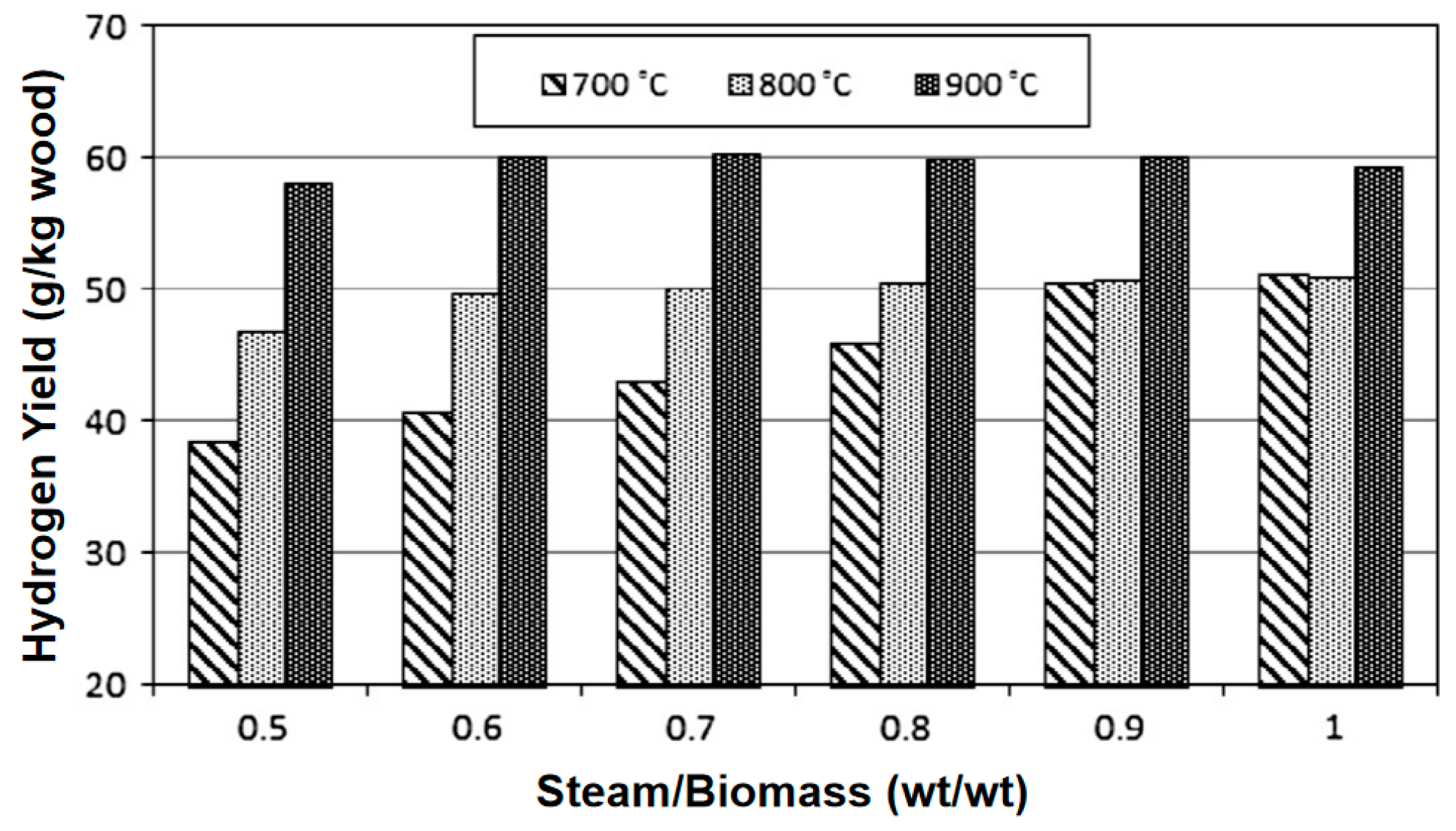
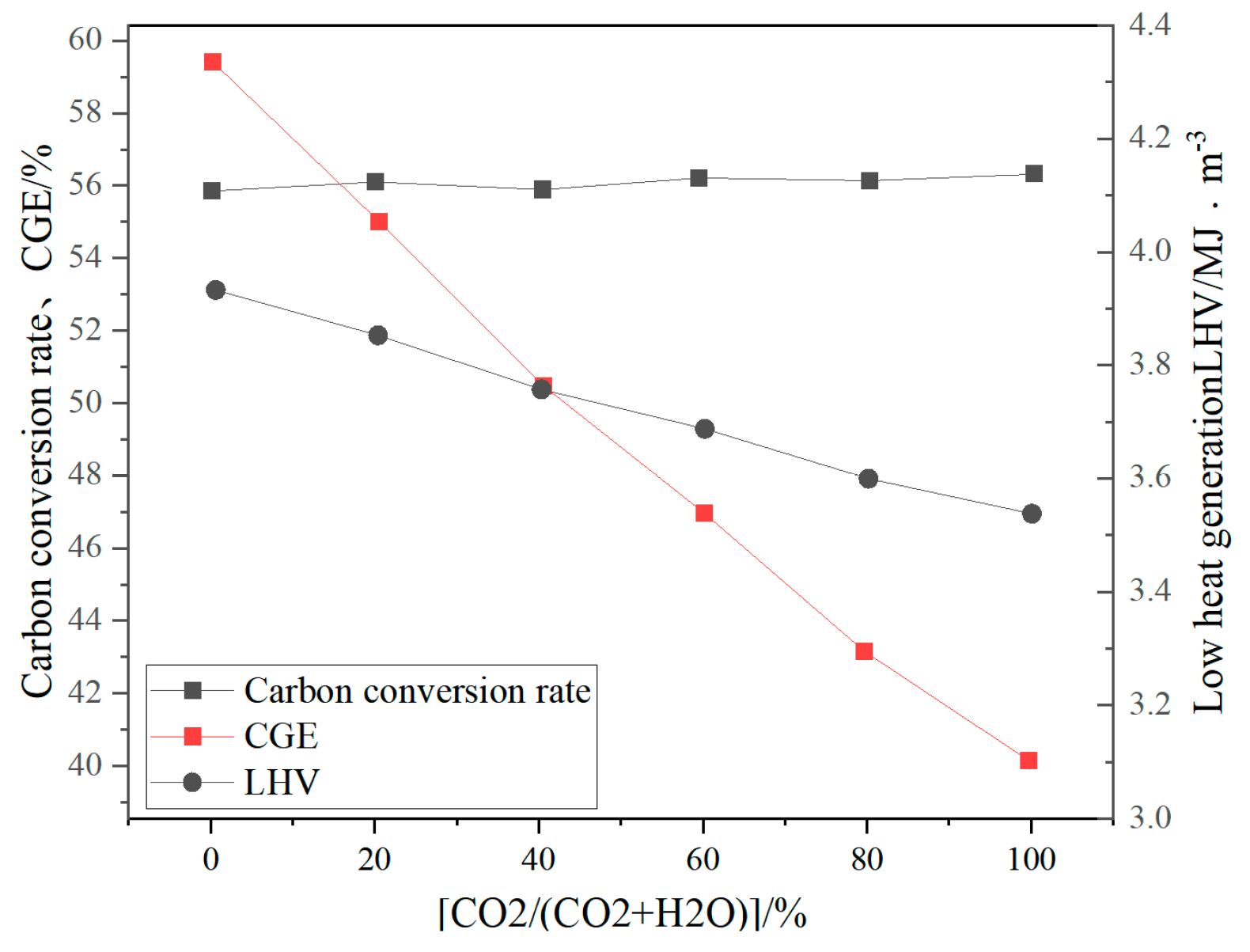
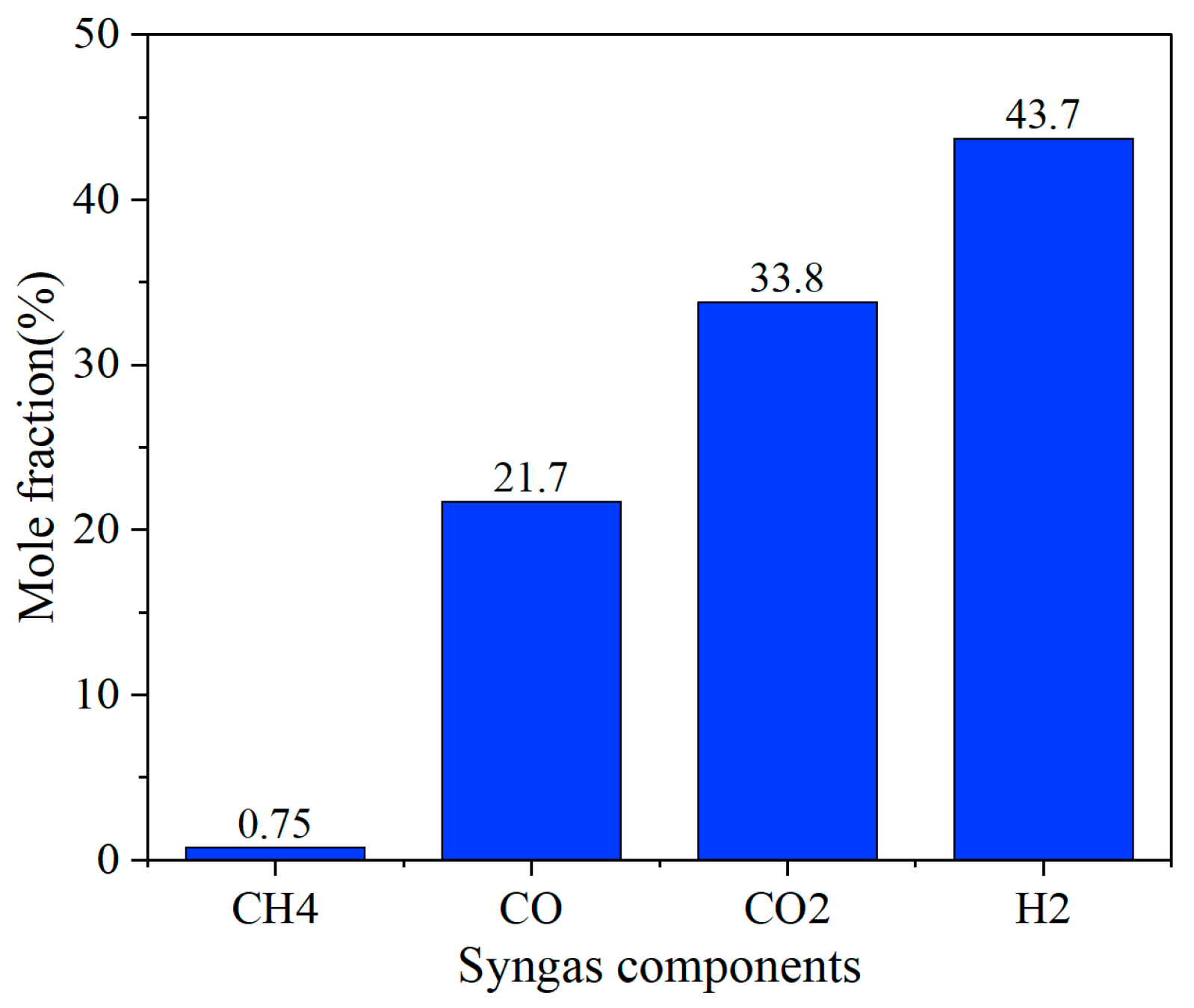
| Indicator | Fixed-Bed | Fluidized-Bed | Dual Fluidized-Bed |
|---|---|---|---|
| Carbon Conversion Rate (%) | 60–75 | 80–95 | 85–98 |
| Tar Content (g/Nm3) | 1–10 | 0.5–2.0 | <0.1 |
| Syngas Heating Value (MJ/m3) | 4–11 | 8–17 | 12–15 |
| Feedstock Adaptability | Low (particle size constraints) | High (powder/granular) | Moderate (requires pretreatment) |
| Investment Cost | Low | Medium | High |
| Oxygen Usage Ratio | Syngas Component Volume Fraction | Syngas Calorific Value/(MJ·m−3) | Gas Production Rate/(L·g−1) | ||||
|---|---|---|---|---|---|---|---|
| H2 | CH4 | CO | CO2 | C2Hm | |||
| 0.21 | 30.58 | 9.08 | 26.74 | 31.25 | 2.34 | 11.42 | 1.33 |
| 0.24 | 29.79 | 9.78 | 27.28 | 30.67 | 2.48 | 11.74 | 1.32 |
| 0.27 | 27.02 | 8.88 | 23.56 | 38.40 | 2.14 | 10.43 | 1.35 |
| 0.30 | 32.04 | 8.82 | 26.34 | 30.55 | 2.24 | 11.37 | 1.40 |
| 0.33 | 31.59 | 8.77 | 25.34 | 32.04 | 2.26 | 11.19 | 1.42 |
| Gasification Medium | H2 Volume Fraction (%) | Syngas Calorific Value (MJ/Nm3) | Tar Content (g/Nm3) | Gasification Efficiency (%) |
|---|---|---|---|---|
| Air | 15–20 | 4–6 | 10–20 | 40–50 |
| O2 | 25–35 | 10–12 | 3–5 | 65–75 |
| H2O | 40–50 | 8–11 | 1–3 | 55–65 |
| Air/H2O | 18–25 | 4–8 | 3–5 | 55–65 |
| Air-O2/H2O | 25–30 | 6–10 | 1–3 | 65–75 |
| O2/H2O | 25–40 | 11–13 | 0.5–3 | 75–85 |
Disclaimer/Publisher’s Note: The statements, opinions and data contained in all publications are solely those of the individual author(s) and contributor(s) and not of MDPI and/or the editor(s). MDPI and/or the editor(s) disclaim responsibility for any injury to people or property resulting from any ideas, methods, instructions or products referred to in the content. |
© 2025 by the authors. Licensee MDPI, Basel, Switzerland. This article is an open access article distributed under the terms and conditions of the Creative Commons Attribution (CC BY) license (https://creativecommons.org/licenses/by/4.0/).
Share and Cite
Wang, L.; Zhou, T.; Hou, B.; Yang, H.; Hu, N.; Zhang, M. A Comprehensive Review of Biomass Gasification Characteristics in Fluidized Bed Reactors: Progress, Challenges, and Future Directions. Fluids 2025, 10, 147. https://doi.org/10.3390/fluids10060147
Wang L, Zhou T, Hou B, Yang H, Hu N, Zhang M. A Comprehensive Review of Biomass Gasification Characteristics in Fluidized Bed Reactors: Progress, Challenges, and Future Directions. Fluids. 2025; 10(6):147. https://doi.org/10.3390/fluids10060147
Chicago/Turabian StyleWang, Lu, Tuo Zhou, Bo Hou, Hairui Yang, Nan Hu, and Man Zhang. 2025. "A Comprehensive Review of Biomass Gasification Characteristics in Fluidized Bed Reactors: Progress, Challenges, and Future Directions" Fluids 10, no. 6: 147. https://doi.org/10.3390/fluids10060147
APA StyleWang, L., Zhou, T., Hou, B., Yang, H., Hu, N., & Zhang, M. (2025). A Comprehensive Review of Biomass Gasification Characteristics in Fluidized Bed Reactors: Progress, Challenges, and Future Directions. Fluids, 10(6), 147. https://doi.org/10.3390/fluids10060147











